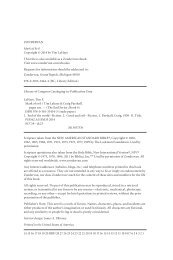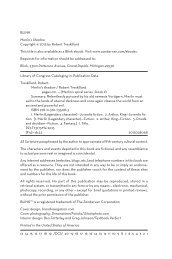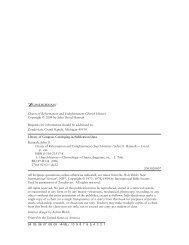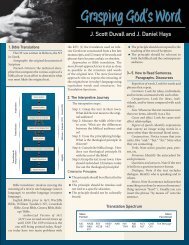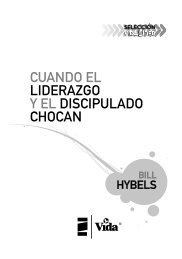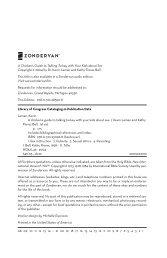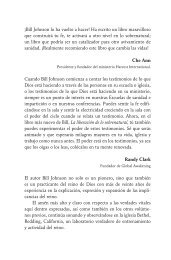Sacred Space: A Hands-On Guide to Creating Multisensory Worship ...
Sacred Space: A Hands-On Guide to Creating Multisensory Worship ...
Sacred Space: A Hands-On Guide to Creating Multisensory Worship ...
- No tags were found...
You also want an ePaper? Increase the reach of your titles
YUMPU automatically turns print PDFs into web optimized ePapers that Google loves.
<strong>Sacred</strong> <strong>Space</strong>: A <strong>Hands</strong>-<strong>On</strong> <strong>Guide</strong> <strong>to</strong> <strong>Creating</strong> <strong>Multisensory</strong> <strong>Worship</strong> Experiences for Youth MinistryCopyright 2008 by Dan Kimball and Lilly LewinYouth Specialties resources, 300 S. Pierce St., El Cajon, CA 92020 are published by Zondervan, 5300 Patterson Ave. SE,Grand Rapids, MI 49530.ISBN 978-0-310-27111-6All Scripture quotations, unless otherwise indicated, are taken from the Holy Bible, Today’s New International Version. TNIV ® .Copyright 2001, 2005 by International Bible Society. Used by permission of Zondervan. All rights reserved.All rights reserved. No part of this publication may be reproduced, s<strong>to</strong>red in a retrieval system, or transmitted in any form orby any means — electronic, mechanical, pho<strong>to</strong>copy, recording, or any other — except for brief quotations in printed reviews,without the prior permission of the publisher.Cover design by SharpSeven DesignInterior design by Brandi Etheredge DesignPrinted in the United States of America08 09 10 11 12 13 14 • 20 19 18 17 16 15 14 13 12 11 10 9 8 7 6 5 4 3 2 1
CONTENTSHOW TO USE THIS BOOK ..................................................8What’s in <strong>Sacred</strong> <strong>Space</strong>? ...............................................8Don’t Feel Limited ......................................................9Before You Begin ........................................................9Remember… ..............................................................9Some Definitions ........................................................9Bases for Prayer Stations ...........................................34Signs/Directions .......................................................34Using Scent ..............................................................35Lighting ...................................................................35Specific Stations ........................................................35What Not <strong>to</strong> Do When Leading/Organizinga Prayer Room ....................................................36PART 1: THE WHYS AND HOWSOF SACRED SPACEChapter 1—What Is Experiential <strong>Worship</strong>…and Why Should I Care? ...................................................11So…What Is Experiential <strong>Worship</strong>? ..........................12A Few Lessons Learned along the Way ......................12Chapter 2—Why We Need Experiential <strong>Worship</strong>and <strong>Sacred</strong> <strong>Space</strong> ..............................................................13A Biblical Mandate ...................................................14Understanding the Limitations of the “Sermon” ........16Knowing How We Learn Is Crucial <strong>to</strong> SpiritualGrowth & How We Teach ...................................16The Four Learning Styles ..........................................17Chapter 3—How We Got Started:Our Journeys <strong>to</strong> Experiential <strong>Worship</strong>..............................18Lilly’s Journey ...........................................................18Dan’s Journey ...........................................................20Chapter 4—“So, How Do I Do This?”The Power of S<strong>to</strong>ry and the Experiential Process .......22Chapter 5—Building Your Team .......................................27The “Palette” Team Approach ....................................27Building a Team Will Take Time ...............................28Getting Started .........................................................28Chapter 6—Baby Steps .....................................................30Chapter 7—Helpful Hints for Experiential<strong>Worship</strong>/Prayer Station Setup ..........................................32Become an Atmosphere Architect .............................32Table Coverings ........................................................33PART 2: PRAYER STATIONS ANDCOMMUNAL ART EXPRESSIONS FROMDAN’S COMMUNITYBe the Church (1 Communal Art Expression;3 Prayer Stations)Communal Art Expression—Be the Church: “I Dream of a Church…” .......................40Themes: Mission, Spiritual Gifts, theChurch, CharacterPrayer Station—Be the Church: Using Our Gifts ...........41Themes: Mission, Spiritual Gifts, the ChurchPrayer Station—Be the Church: Community ................42Themes: Mission, Spiritual Gifts, the Church,Community/FellowshipPrayer Station—Be the Church: Communion ...............44Themes: Mission, the Church, Scripture/Theology,<strong>Worship</strong>, Community/FellowshipThe Beatitudes (2 Communal Art Expressions)Communal Art Expression—The Beatitudes: The Light of Christ ...............................46Themes: Attitudes of the Heart, Authenticity,Purity, Mercy, Persecution, Living inthe Kingdom, EvangelismCommunal Art Expression—The Beatitudes: Paintings ....48Themes: Attitudes of the Heart, Authenticity, Purity,Mercy, Persecution, Living in the KingdomBelonging (2 Communal Art Expressions)Communal Art Expression—Belonging: Mosaic ...........51Themes: Purpose, Church, Salvation,Identity, Mission
Prayer Station 0: Introduction <strong>to</strong>the Tables Experience ..................................................137Prayer Station 1—Psalm 23: God Prepares a Table ......137Prayer Station 2: The Calling of Levi ...........................138Prayer Station 3—Table Interrupted:Jesus Anointed by a Sinful Woman ..............................139Prayer Station 4: At the Table with Mary and Martha .....140Prayer Station 5—Trouble at the Table:Washing the Cup .........................................................141Prayer Station 6—Table Excuses:Jesus at a Pharisee’s House ...........................................142Prayer Station 7: Last Supper ......................................143Prayer Station 8: <strong>On</strong> the Road <strong>to</strong> Emmaus ..................144Prayer Station 9: Table by the Sea(Breakfast by the Beach) ..............................................145Prayer Station 10: Art Table ........................................146Prayer Room: Do Justice ..............................................147Prayer Station 0: Intro Station .....................................148Prayer Station 1: Sowing Seeds ....................................148Prayer Station 2: Praying Globally! .............................149Prayer Station 3: Water Station....................................150Prayer Station 4: Art Station .......................................151Prayer Station 5: Praying the News ..............................152Prayer Station 6: Ending Slavery .................................153Prayer Station 12: Eradicate Extreme Povertyand Hunger ......................................159Prayer Station 13: Wailing Wall ...................................160Prayer Experience: The Life of David ..........................161Welcome/Intro Station ................................................162Prayer Station 1: Samuel the Prophet/Walking<strong>to</strong> Bethlehem ...............................................................163Prayer Station 2: Praying for Our Families ..................164Prayer Station 3: Praying for Others............................165Prayer Station 4: Praying for Yourself .........................166and the Heart of GodPrayer Station 5: Anointing Station .............................168Prayer Station 6—Killing Goliath:Looking at the Giants in Your Life...............................169Prayer Station 7: Whose Armor Are You Wearing? .....170Prayer Station 8: David the Songwriter .......................171Prayer Station 9: Honoring Your Enemies andPraying for Those Who Persecute You (andPraying for Our World) ...............................................172Prayer Station 10: Bathsheba(Opportunity <strong>to</strong> Repent) .............................................173Prayer Station 11: David as the Delivery Boy ..............174Chill <strong>Space</strong> ..................................................................175Wailing Wall ................................................................175Art <strong>Space</strong>/Art Station ..................................................176Prayer Station 7: Healing Our World ..........................154Prayer Station 8: Praying for Your Country ................155Prayer Station 9: Jesus Holds All Things Together .......156Prayer Station 10: Take a Stand…Live Justly ...............157Prayer Station 11: Reduce Child Mortalityand Improve Maternal Health .....................................158
Chapter 1What Is Experiential <strong>Worship</strong>—and Why Should I Care?Imagine a wall covered in butcher paper where your students are writing their prayers in coloredmarkers, pouring out their hearts, their pain, and their fears. Writing prayers <strong>to</strong> God that they’dnever speak out loud in a million years.Imagine them running their fingers through a bin of sand <strong>to</strong> finally find a large pearl—andthen realizing that God searches for them like that, and they’re <strong>to</strong> search for God like that, <strong>to</strong>o.Imagine them walking in<strong>to</strong> a room with an inflated raft in the center, and they’re asked <strong>to</strong>physically stand in the boat and actually consider what they feel as Jesus calls them <strong>to</strong> followhim. What things keep them stuck in the raft? What fears do they feel as Jesus calls them? Thenthey each talk <strong>to</strong> Jesus about leaving their nets, their families, their lives—everything familiar <strong>to</strong>them—<strong>to</strong> become, like Peter, fishers of humanity.Those are just a few of the multisensory ways <strong>to</strong> pray that involve us as participants as werespond <strong>to</strong> the Bible not just with our ears, but with our whole selves. This was the responseJesus was after—and the means by which he communicated the Kingdom of God.Jesus <strong>to</strong>ld s<strong>to</strong>ries, painted word pictures, and used common objects that were familiar<strong>to</strong> people in his time (e.g., the lily, the fig tree, the bread on the table) <strong>to</strong> capture mindsand hearts.What if we did the same?What if the Holy Spirit involved all of our senses in worship in addition <strong>to</strong> listening <strong>to</strong>words? What if worship weren’t just black and white and scripted?When designing worship we have <strong>to</strong> ask the question, “What do we want them <strong>to</strong> takehome? What do we want them <strong>to</strong> remember, <strong>to</strong> actually get out of what we’re teachingand doing?”That’s where experiential worship begins.It empowers us <strong>to</strong> embrace Scripture and prayer in new ways.11
It provides God encounters—opportunities <strong>to</strong> go deeper in our relationship with Jesus.Experiential worship helps us connect our s<strong>to</strong>ries with God’s s<strong>to</strong>ry.So…What Is Experiential <strong>Worship</strong>?Experiential worship brings all five senses in<strong>to</strong> play. It’s fresh and alive. It’s active, not sedentary.It’s engaging, not passive. It’s new <strong>to</strong> each person, each day. It tells the s<strong>to</strong>ry—the goodnews of the gospel—with <strong>to</strong>uch, taste, scent, sight, and sound. It evokes tangible responses.It involves imagery—not just words. It involves individuals as well as the group—and everybodygets <strong>to</strong> respond, not just the leaders or the paid professionals. There’s always something<strong>to</strong> see and do. It involves us in powerful prayer. It encourages us <strong>to</strong> respond <strong>to</strong> the biblicalcontent.Think about the instances in the Bible that describe the Crea<strong>to</strong>r’s visual, tactile revelation—andthe created’s visual, tactile worship in response: Jacob pouring oil over a s<strong>to</strong>newhere he encountered God, Joshua and the s<strong>to</strong>nes of remembrance from the Jordan River…just <strong>to</strong> name a few.Experiential worship means using all the means at our disposal <strong>to</strong> open similar doors <strong>to</strong>encounters, communion, and connection with God.A Few Lessons Learned along the Way1. We remember what we do twice as well as what we’re <strong>to</strong>ld. Experiential worship opensthe door <strong>to</strong> a higher degree of learning for youth who learn more experientially.2. Experiential worship ideally allows youth who otherwise may not have a place <strong>to</strong>share and express their creative gifts (not just musical or speaking) <strong>to</strong> do so as par<strong>to</strong>f a worship gathering.3. Don’t be discouraged if a prayer station or prayer experience doesn’t connect. Just aswith teaching messages, sometimes some youth may not connect with what you’redoing at that particular meeting.12
Chapter 2Why We Need Experiential<strong>Worship</strong> and <strong>Sacred</strong> <strong>Space</strong>We need experiential worship because our culture no longer “gets” or even knows the s<strong>to</strong>ry ofGod. Most of our students can’t tell you the difference between the Old and New Testamentsor even the names of the four Gospels. Even our “churched” students don’t always know howthe Bible relates <strong>to</strong> their lives.We have a problem in “church land,” <strong>to</strong>o. We’ve forgotten how <strong>to</strong> tell the s<strong>to</strong>ry of God.And why is this?In the late 1970s and in the 1980s, many churches viewed pews and stained glass (andother symbols) as boring and outdated. It didn’t help that many of these people had negativechurch experiences in more traditional settings. So they changed the atmosphere and createdmore user-friendly churches. <strong>Worship</strong> spaces were designed without the traditional trappingssuch as altars, or even crosses. Now many church buildings resemble movie theaters withtheir stadium seating, cup holders, and large video screens.But when they got rid of the symbols, they got rid of elements that helped “tell the s<strong>to</strong>ry.”In medieval times, elements such as stained glass and other artwork actually <strong>to</strong>ld the biblicalnarrative <strong>to</strong> many in the church who couldn’t read. Even the ceilings in some churchbuildings were designed <strong>to</strong> look like upside-down boats <strong>to</strong> remind believers of the call <strong>to</strong>be fishers of people. The spires and steeples were reminders of God, pointing churchgoers<strong>to</strong> heaven.<strong>On</strong> the flip side, <strong>to</strong>day’s liturgical/traditional churches still have loads of symbols and rituals.In the traditional liturgy each piece of the worship service tells a part of the s<strong>to</strong>ry—eventhe congregants’ physical movements enhance the s<strong>to</strong>ry (e.g., making the sign of the cross,kneeling, reading a Bible passage in the midst of the congregation <strong>to</strong> show that it’s God’s Wordfor everyone). But the problem is that many in liturgical churches no longer know why theyuse these symbols and rituals. They’ve lost their meaning.13
Experiential worship brings the living portions of both styles and traditions <strong>to</strong>gether. Itgives symbols new life and helps emerging generations fall in love with God.What’s more, our lives are so visually driven <strong>to</strong>day that we often don’t even need words <strong>to</strong>describe things or get our point across. Therefore throwing out symbols (and then forgettingthe meanings of these symbols) as a church has eliminated our ability <strong>to</strong> tell the s<strong>to</strong>ry of God <strong>to</strong>an extremely symbolic, visual culture that’s no less hungry for the good news and the s<strong>to</strong>ry ofGod than any other generation. Our culture needs churches that learn again how <strong>to</strong> use symbols.People need churches that teach in ways that engage them, help them engage with God,and enable them <strong>to</strong> experience with all their senses how God relates <strong>to</strong> their everyday lives.A Biblical MandateAn important chapter in The Emerging Church discusses the Bible and worship. 1 Revisitingwhat was covered there, it’s easy <strong>to</strong> see that the Bible very clearly speaks of worship usingother means than simply words. Since <strong>Sacred</strong> <strong>Space</strong> discusses incorporating a variety of expressionsof worship and prayer that involve various senses, it’s good <strong>to</strong> understand that theconcept of experiential worship and prayer does have biblical backing. For instance, whenyou look at worship in the Old Testament, you see that the temple in Jerusalem used muchmore than sermons <strong>to</strong> “get God across.” Every sense was involved: You could smell the burningsacrifices and incense, hear the trumpets and temple choirs, see transcendent architectureof soaring pillars and expansive courtyards. Even the texture and colors of the priests’ clothingcommunicated specific things about God and God’s covenant with Israel.In other places in the Scriptures you can read about other forms of worship and prayerthat involve the senses:Sense of Smell. We see in Revelation 8:4 how incense is used in worship. Throughout theOld Testament incense was common in worship (Exodus 25:6; Malachi 1:11). We see theMagi presenting Jesus with gifts that were multisensory (Matthew 2:11). Philippians 4:18 refers<strong>to</strong> “a fragrant offering...pleasing <strong>to</strong> God.” Even the church itself is <strong>to</strong> be the “aroma of theknowledge of him…the pleasing aroma of Christ” (2 Corinthians 2:14-15).Sense of Touch. We also know that the sense of <strong>to</strong>uch was involved in all forms and practicesof worship. Believers laid hands on others when they prayed (Acts 6:6), clapped theirhands (Psalm 47:1), felt the water as they were baptized (Acts 8:38), and <strong>to</strong>uched the bread incommunion (1 Corinthians 11:23-24).Sense of Taste. The sense of taste is acknowledged quite often in the Bible. Psalm 34:8 says,“Taste and see that the Lord is good.” Psalm 119:103 reads, “How sweet are your words <strong>to</strong> my1Dan Kimball, The Emerging Church: Vintage Christianity for NewGenerations (Grand Rapids, Zondervan, 2003) 127-131.14
taste, sweeter than honey <strong>to</strong> my mouth!” In Revelation 10:10 John writes: “I <strong>to</strong>ok the littlescroll from the angel’s hand and ate it. It tasted as sweet as honey in my mouth, but when I hadeaten it, my s<strong>to</strong>mach turned sour.” The taste of bread and wine are involved in communion (1Corinthians 11:23-26).Sense of Hearing. We all know <strong>to</strong> what a great degree music was involved in worship—every kind of sound of praise happened, whether from voices or from musical instruments(Psalm 150). Jesus sang (Matthew 26:30). The Scriptures were preached (Acts 2:14).Sense of Sight. Throughout the Scriptures we see in great detail how visual worship hasbeen. Whether it’s the beauty of worship in the tabernacle (Exodus 25:3-7; 26:1-2) or in thetemple (1 Kings 6:29-30), we see detailed descriptions of color, texture, and design.The Scriptures also show God using object lessons, miraculous events, and supernaturaldisplays of power <strong>to</strong> help people learn about and respond <strong>to</strong> the Almighty in worship. Goddidn’t just “speak” using words; God spoke with a burning bush. God didn’t just dictate thelaw; God wrote it with his own finger. God didn’t just lead Israel through the desert; God ledthem with a pillar of fire. Jesus didn’t simply heal the blind man; Jesus made mud with hissaliva and smeared it over his eyelids.God’s prophets did outlandish things in order <strong>to</strong> communicate truth using more thanwords: Isaiah walked around <strong>to</strong>wn naked for three years; Ezekiel lay on his side for weekson end, building little miniature villages out of mud; Jeremiah carried around rotten fruit.Even if people refused <strong>to</strong> obey the prophets’ instructions, they certainly wouldn’t forget whatthey had heard, seen, and smelled. When you look in<strong>to</strong> the prophecies and descriptionsin the book of Revelation, there are all kinds of colors, visuals, smells, and even tastesinvolved (10:10).The Bible shows that involving more than words in worship and teaching is a valid andpowerful thing <strong>to</strong> do. There isn’t a biblical mandate for worshiping in only one way. Whenwe’re locked in<strong>to</strong> only one way of worship and teaching, we’re worshiping according <strong>to</strong> ouropinions, not according <strong>to</strong> the Bible. In fact, the way in which we worship has changed throughtime. The Magi worshiped Jesus by bowing down (Matthew 2:11). The disciples worshipedJesus by falling down and clasping his feet (Matthew 28:9) and sitting in a boat (Matthew14:33). But even beyond the where’s and how’s of worship, the most important questions are,Are we engaging with God? and Are our lives changing?<strong>On</strong>e question we hear as we teach around the country is “Do you still believe in teachingthe Bible with words?” Our answer is an emphatic “yes”! We hope you’re picking that up bynow. Teaching the Bible is critically important. Teaching with words is critically important.15
UNDERSTANDING THE LIMITATIONSOF THE “SERMON”Studies have shown that within aweek, an incredibly high percentageof people can’t recall what wastaught in the sermon the week before.Think about it. How much doyou remember from the sermon lastweek? How about two weeks ago?Three weeks ago? I’ve found youcan ask the preachers themselveswhat they taught two weeks before—and even they have a hard time remembering.I’m not saying sermonsaren’t needed, or that they don’thelp people grow. At Vintage FaithChurch, the sermons run 35 <strong>to</strong> 45minutes long each week. Sermonsare important.But let’s be realistic. In terms oflisteners remembering and internalizingsermons—even a week or twoweeks later—we often believe sermonshave greater staying powerthan they actually do.What we desire through experientialworship is <strong>to</strong> enhance the learningand enhance the remembering.It’s important <strong>to</strong> also create ways forstudents <strong>to</strong> be in the Scriptures andlearn outside of the worship service.In youth ministry, perhaps we canbe teaching theology, apologetics,church his<strong>to</strong>ry, and how <strong>to</strong> study theBible as a normal part of what we do.Small groups are another major waywe help students learn and developthe skills of personal Bible study. Bu<strong>to</strong>ur single gathering each week mustbe designed <strong>to</strong> have the maximumimpact on students’ lives. That’s whywe believe paying attention <strong>to</strong> howstudents learn in our main youthgatherings is very important.—Dan KimballWhat we teach about God shapes our attitudes <strong>to</strong>wardGod. However, we need <strong>to</strong> also consider that teachingnonverbally is a valid and necessary (and biblical) way <strong>to</strong>teach as well.We should always be asking ourselves, Is how wepreach based on the Bible, or is it our own particular preference?For example, the Bible never says that we shouldgive three- or four-point sermons. The Bible never sayswe should always end sermons with application points.What it says is <strong>to</strong> watch doctrine and preach with the wisdomand power of the Spirit, not our own wisdom andpower. So there may be many valid ways <strong>to</strong> preach—andwe rather should be asking ourselves, Is our preaching accurateaccording <strong>to</strong> Scripture? and Is our preaching effectiveand changing lives?This book is designed <strong>to</strong> assist you in proclaimingthe truths of Scripture and doing it in new ways <strong>to</strong> moredeeply reach your students.So please understand; we don’t view experiential,multisensory worship as simply a fad. We don’t see this aswatering down the Scriptures. We see this as teachingthe Scriptures in ways that help students learn and rememberthem.Knowing How We Learn Is Crucial<strong>to</strong> Spiritual Growth and How We TeachDid you know that research shows that only 20 percent ofthe world learns through their ears? Thus, if we want theother 80 percent of us (and our students) <strong>to</strong> “get” the s<strong>to</strong>ryof God, then we need <strong>to</strong> teach the Bible in more ways thansimply audi<strong>to</strong>ry (i.e., sermons or talks).Of course this doesn’t just mean simply adding a videoor a slide show <strong>to</strong> your “up front” time. The latter visualsare fine, but they still make the members of your group16
the “audience,” not the participants. Instead we need <strong>to</strong>involve them in the s<strong>to</strong>ry—<strong>to</strong> <strong>to</strong>uch it, taste it, discuss it,and place themselves in it. To experience it.THE FOUR LEARNING STYLESHow are you using these in your worshipgatherings or when you teach?Tactile/Kinesthetic – you best learnby doing/<strong>to</strong>uchingVisual – you best learn by seeing(words and pictures)Audi<strong>to</strong>ry – you best learn by hearing(Fleming’s VARK approach adds“Writing/Reading”)By the sixth grade we’ve usually developeda learning style that will generallyremain constant the rest of ourlives. According <strong>to</strong> Marlene LeFever,for every 10 students in an averagesixth-grade class, one will find 2 :• 2 audi<strong>to</strong>ry learners• 4 visual learners• 4 tactile/kinesthetic learnersThat means eight out of 10 peoplearen’t taught in the ways they bestlearn—yet 90 percent of teachingin our churches is audi<strong>to</strong>ry! (What’salso interesting is that most preachersare audi<strong>to</strong>ry learners—i.e., mostpreachers communicate and teachin a way that reflects their learningstyle. Which only is the best way that20 percent of people learn!)An old Chinese proverb says, “Ihear and I forget; I see and I remember;I do and I understand.” This iscore motive of experiential prayerand worship—that students see, remember,do, and understand theScriptures.172Marlene LeFever, Learning Styles: Reaching EveryoneGod Gave You <strong>to</strong> Teach (David C. Cook, 2002).



